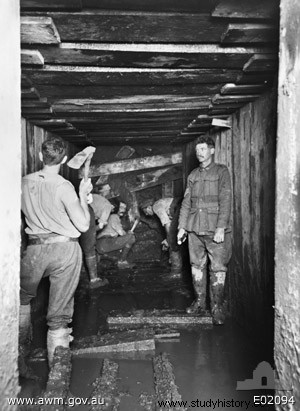On June 7, 1917, the British 2nd Army, under the command of English Field Marshal Herbert Plumer , began an offensive on the Western Front during the First World War, with the purpose of taking a small mountain range, as a natural fortress, between the Belgian towns of Messines and Ypres... the Battle of Messines . In the plan of attack, designed by Plumer himself, the artillery, infantry and, above all, the engineering corps assisted by geologists would participate. First, the engineers should tunnel underground to the base of the rise, under the German defenses, and plant several mines/bombs.

Tunnels in Messines
They had to deal with the difficulties of the terrain and with the countermines of the Germans but they achieved their objective. Since May 21, the British artillery was punishing the crest of the mountain range... at 2:50 in the morning of June 7, the ceasefire was given. Herbert Plumer met with the controls and said:
Gentlemen, tomorrow we may not make history, but we will surely change the orography.
At 3:10 the order was given to detonate the mines... 600 tons of explosives spread over 19 mines . The explosion of the mines alone killed almost 10,000 German soldiers and destroyed most of the fortifications. The subsequent infantry attack was a complete success and in a few hours they achieved their objectives. Subsequent German counteroffensives only succeeded in increasing the number of casualties. This is the detail of the mines that exploded:
| Mine name | Load (lbs) | Diameter of the crater |
|---|---|---|
| 60A Hill | 53,500 | 191 feet |
| Hill 60 B | 70,000 | 260 feet |
| St Eloi | 95 600 | 176 feet |
| Hollandscheschour 1 | 34,200 | 183 feet |
| Hollandscheschour 2 | 14,900 | 105 feet |
| Hollandscheschour 3 | 17,500 | 141 feet |
| Petit Bois 1 | 30,000 | 175 feet |
| Petit Bois 2 | 30,000 | 217 feet |
| Maedelstede Farm | 94,000 | 217 feet |
| Peckham | 87,000 | 240 feet |
| Spanbroekmolen | 91,000 | 250 feet |
| Kruisstraat 1 | 30,000 | 235 feet |
| Kruisstraat 2 | 30,000 | 217 feet |
| Kruisstraat 3 | 30,000 | 202 feet |
| Ontario Farm | 60,000 | 200 feet |
| 127 Trench left | 36,000 | 182 meters |
| 127 Right Pit | 50,000 | 210 feet |
| 122 Left Pit | 20,000 | 195 feet |
| 122 Right Pit | 40,000 | 228 feet |
The problem is that not only were 19 mines planted, some mines did not explode and the British forgot/lost the exact location data. One of the mines, the one under the ruined farmhouse Petite Douve , it seems that it had been found by the Germans and destroyed but an article in The Telegraph He says he's still under a barn on the farm. In addition, the Mahieu family , rebuilt the farm, today called Basse Cour , and she lives in it with 22 tons of explosive under her feet.
Doesn't keep me from sleeping at night. It's been there all this time, why would it explode now?
I wouldn't be so calm... June 17, 1955, during a storm, near Le Pelerin , lightning struck an electric pole that, coincidences of life, was located on another disappeared mine and caused it to explode. The only victim was a cow. But worst of all, it is known for sure that there is another mine, close to this last one, whose exact position has not yet been located.
